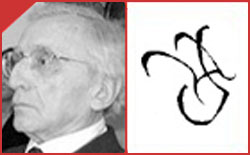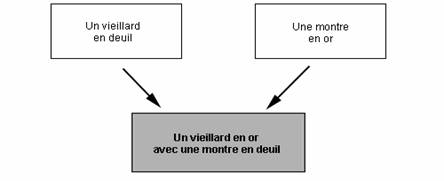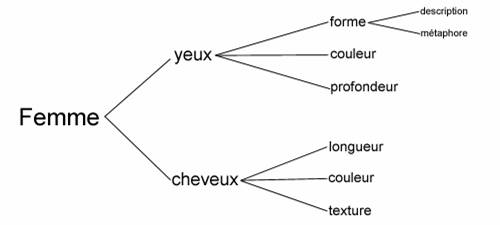Available Languages
- Consultez cette page en FRANÇAIS
- Consult this page in ENGLISH
Text Derivation
By Johanne Prud’homme and Nelson Guilbert
Université du Québec à Trois-Rivières
1. ABSTRACT
Riffaterre

According to Michael Riffaterre, the poetic text is structured in such a way that it repeats many variants of the same invariant. This invariant is the semantic nucleus of the text, to which Riffaterre eventually gives the name "hypogram". The hypogram, which determines and generates the written poem, is an important index in understanding the poem. We can find the hypogram of a text by bearing in mind the various rules governing its creation: overdetermination, conversion and expansion.
This text may be reproduced for non-commercial purposes, provided the complete reference is given:
Johanne Prud’homme and Nelson Guilbert (2006), « Text Derivation », in Louis Hébert (dir.), Signo [online], Rimouski (Quebec), http://www.signosemio.com/riffaterre/text-derivation.asp.
2. THEORY
According to Michael Riffaterre, the poetic text is structured so that it repeats many variants of the same invariant. This invariant is the semantic nucleus of the text, and Riffaterre names it the "hypogram".
2.1 THE NUCLEUS OF THE TEXT
Utilitarian language and literary language function in very different ways. In everyday language, "meaning is based on multiple referents, and the truth of a text is established through its contacts with reality" (Riffaterre 1983, 88). In contrast, the literary text has only one referent, which is found neither in reality nor in the author's intention. For Riffaterre, any text is derived through the complex interplay of variations and modulations on one single structure "[…]- thematic, symbolic, or whatever – […] and this sustained relation to one structure constitutes the significance" (Riffaterre, 1978, 6).
The text, then, is composed of variants on a single invariant. Riffaterre initially names this invariant structure the semantic nucleus. This nucleus acts "as if it were a suppressed neurotic symptom. Its very suppression causes it to pop up elsewhere in the text with a flourish of other symptoms, that is, of other synonyms or periphrases" (Riffaterre, 1983, 76).
NOTE: THE SEMANTIC NUCLEUS
This definition of the semantic nucleus inevitably brings to mind psychoanalytic theories on the resurfacing of repressed memories and dream development. The principles of conversion and expansion, which we will examine later, are also reminiscent of psychoanalytical concepts, such as condensation and displacement, as they relate to dream work.
The idea of a nucleus that governs the entire process of writing a literary text is the foundation of Riffaterre's theory of poetic writing, its structure and its functions; this central concept of his eventually acquires the term "hypogram" as its name.
2.2 PARAGRAM AND HYPOGRAM
The hypogram is based on the Saussurean concept of the paragram. In Saussure's theory, this term designates a key word, or theme-word, whose lexical and graphemic constituents would be embedded and disseminated within the text. In other words, the text would be saturated with a phonic paraphrase of the theme-word.
Saussure's genius, according to Riffaterre, was in understanding that the text's centre is found in a structural system inherent to the text, not in outside elements. "The text's true significance lies in its consistent formal reference to and repetition of what it is about, despite continuous variations in the way it goes about saying it" (Riffaterre, 1983, 76).
The phonic and graphemic traces of a theme-word are not always discernable when reading the text, though. So rather than expecting a nuclear word to emerge from the phonetic and graphemic repetitions, we must look for it in the structure of the text. This "semantic paragram", which is found in the textual structure itself, is precisely what constitutes the hypogram.
The kind of hypogram may vary. A word, an idea, a sentence taken from a well-known text, a cliché (which may be maintained or subverted): all of these are possible hypograms. Riffaterre uses the general term matrix to convey the idea that the hypogram, no matter what kind it is, determines the structure of the text.
To gain a solid understanding of the hypogram, we must consider the process by which a matrix becomes a literary text. This process involves three basic rules underlying the literary sentence; they illustrate how the text is derived, and they are keys to finding a text's hypogram: (1) overdetermination, (2) conversion, and (3) expansion.
2.3 OVERDETERMINATION
Overdetermination may be defined as the rule by which signifiers refer not to their signifieds, but rather, to each other, thereby organizing a system of significations that gives the reader the impression that the sentence he is reading is derived from a hypogram.
A process associated with reading, overdetermination takes place when the reader detects recurring elements in the text, both on the semantic and the structural levels. The accumulation of recurring elements reveals an underlying structure and meaning, which is the hypogram.
Overdetermination has three functions:
- To enable mimesis, which is the repetition of elements that makes the text coherent: "The only reference against which [the readers] need to test the narrative's truth is language" (Riffaterre, 1990);
- To make literary discourse exemplary, "by lending it the authority of multiple motivations for each word used" (Riffaterre, 1978, 21);
- To compensate for catachresis, as "the poem may be regarded as a generalized, all-encompassing, all-contaminating catachresis" (Riffaterre, 1978, 21). In other words, through its reference to the hypogram, the text is severed from its mimetic meaning; overdetermination is what compensates for this effect, and because of it, "discourse seems to have its own imperative truth" (1978, 21).
NOTE ON CATACHRESIS
Catachresis is a rhetorical figure that consists of diverting a word’s meaning away from the literal one. Fontanier (1968, 214-216) distinguishes three kinds of catachresis: catachresis by metaphor ("the wings of a castle"), catachresis by metonymy ("Clean that up! The suits are coming in for a meeting.") and catachresis by synecdoche ("If it's a fish, it's a vertebrate").
The three functions together "confer upon the literary text its monumentality: it is so well built and rests upon so many intricate relationships that it is relatively impervious to change and deterioration of the linguistic code" (Riffaterre, 1978, 21).
2.4 CONVERSION
Conversion is the second rule governing literary sentence construction. We may define it as the process by which some component of a set expression or literary cliché is modified, thereby creating a stylistic effect.
As a paradigmatic-type transformation, conversion entails taking a sentence and modifying some constant within it, thereby altering the meaning of the entire sentence (a sort of "comprehensive conversion"). This confers a double meaning on the sentence: that of the initial sentence and that of the transformed sentence. For an accurate analysis of this process, we must examine the converted sentence in relationship to the original sentence. The following diagram illustrates the conversion of two source expressions into one target expression in the first verse of the poem "Cortège" by Jacques Prévert (2000, 238). Each verse of the poem is the result of a conversion.
Diagram of a paradigmatic transformation: the rule of conversion

This type of transformation attracts the reader's attention by deflecting the meaning of the sentence from mimesis and the commonplace toward a new meaning: the meaning motivated by the hypogram. This rule also enables us to "treat the sentence as a unit of style" (Riffaterre, 1983, 45), given that through the use of conversion, the sentence the reader expected has taken a detour, along with its meaning.
2.5 EXPANSION
Expansion is the third rule governing literary sentence construction, and is defined as the process by which each part of a minimal (nuclear, matrix) sentence can engender a more complex form.
As a syntagmatic transformation, expansion basically consists of taking general features and breaking them down into more detailed descriptions. In this way, the literary sentence becomes a "sequence of the explanatory and demonstrative syntagms that drive arbitrariness from clause to clause, further and further away" (Riffaterre, 1983, 61). Expansion is actually what allows the reader to follow the logic of the text, by means of the descriptive details.
Starting from one sentence, one word, or one idea – from a hypogram – it is possible to generate an entire text by describing each part of the sentence, then by breaking down each of these parts in turn.
This is the rule that can show us how a hypogram is transformed into a text: "The transformation of simple components into complex representations makes the literary sentence the grammatical equivalent of an allegorical figure rich in symbolic attributes" (Riffaterre, 1983, 61).
3. APPLICATION
If we take processes such as expansion and conversion and follow them upstream, we can retrace the process of textual derivation and find the hypogram from which it flows, thereby arriving at a better understanding of the literary text's structure and function. You will find an example of each of these processes below.
3.1 AN EXAMPLE OF CONVERSION
Consider a verse taken from Prévert's poem "Cortège" (2000, 239): "le général des huîtres avec un ouvreur de Jésuites" ["the oyster general with a Jesuit opener"].
Conversion is achieved here by using a set expression, "an oyster opener", coupled with another expression, which we restore for the analysis: "the Jesuits' general". By combining these two expressions, the second of which appears to convey a critical message, Prévert subverts both of them, thereby increasing their significance.
3.2 AN EXAMPLE OF EXPANSION
Consider a hypothetical character from a novel, described as a "beautiful woman". If we bring to light to those elements in the text that are generated by the rule of expansion, we can draw a portrait of her. In the specific context of a novel's unique universe, the ongoing description of this woman drives arbitrariness further and further away. By revealing this expansion, the elements of description that allow the reader to follow the logic of the text will become apparent. In the case of our character, the general feature "feminine beauty" must be broken down in all its detail. We will need to describe the parts of her body, among other things, in order to achieve this. As illustrated by the diagram below, the description may be represented in the form of a tree.
Diagram of literary sentence construction: the rule of expansion

4. LIST OF WORKS CITED
- FONTANIER, P., Les Figures du discours, Paris: Flammarion, 1968.
- PRÉVERT, J., Paroles, Paris: Gallimard, "Folio plus", 2000 [1949].
- RIFFATERRE, M., Text Production, New York: Columbia University Press, 1983.
- RIFFATERRE, M., Semiotics of Poetry, Bloomington: Indiana University Press, 1978.
- RIFFATERRE, M., Fictional truth, Baltimore: Johns Hopkins University Press, 1990.
5. EXERCISES
A. The following is a sentence taken from a text by Lautréamont (Lautréamont, Les chants de Maldoror, Paris: José Corti, 1953, p. 307):
Inclinez la binarité de vos rotules vers la terre et entonnez un chant d’outre-tombe. ["Bend the binarity of your kneecaps toward the earth and intone a chant from beyond the grave."]
What would be the conventional expression that Lautréamont used for this conversion? What sort of role do you think this kind of conversion could play?
B. Consider the following poem by Charles Baudelaire (Baudelaire, Les fleurs du mal, Paris: Poulet-Malassis et de Broise, 1861, p. 109-110) or the English translation (by F. P. Sturm, in Mathews, M., The Flowers of Evil, New York: New Directions Publishing, 1963, p. 61):
Le flacon
Parfois on trouve un vieux flacon qui se souvient.
D’où jaillit toute vive une âme qui revient
Mille pensers dormaient, chrysalides funèbres,
Frémissant doucement dans les lourdes ténèbres
Qui dégagent leur aile et prennent leur essor,
Teintés d’azur, glacés de rose, lamés d’or.
Voilà le souvenir enivrant qui voltige
Dans l’air troublé ; les yeux se ferment ; le Vertige
Saisit l’âme vaincue et la pousse à deux mains
Vers un gouffre obscurci de miasmes humains ;
Il la terrasse au bord d’un gouffre séculaire,
Où, Lazare odorant déchirant son suaire,
Se meut dans son réveil le cadavre spectral
D’un vieil amour ranci, charmant et sépulcral.
The Flask
[…]
An ancient flask is brought to light again
And forth the ghosts of long dead odours creep –
There, softly trembling in the shadows, sleep
A thousand thoughts, funereal chrysalides,
Phantoms of old the folding darkness hides,
Who make faint flutterings as their wings unfold,
Rose-washed and azure-tinted, shot with gold.
A memory that brings languor flutters here:
The fainting eyelids droop, and giddy Fear
Thrusts with both hands the soul towards the pit
Where, like a Lazarus from his winding-sheet,
Arises from the gulf of sleep a ghost
Of an old passion, long since loved and lost.

